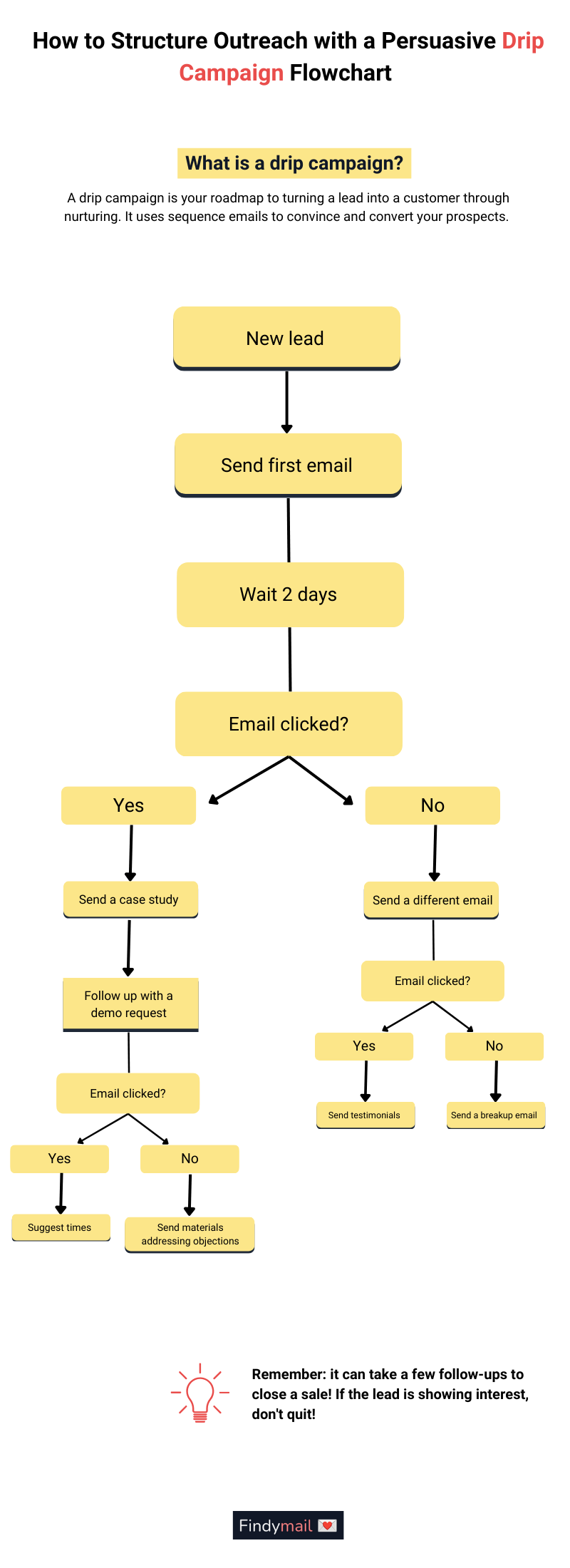Trying to structure emails, following up on leads, wondering how you could telepathically convince your prospects to open your email, and having to check your phone every ten seconds isn't a fun game.
You might feel stuck– like you aren't sure how to write an email that gets the results you want.
Well, I hate to break it to you, but you're right!
Fortunately, drip campaigns make everything 10x simpler.
In this post, you and I will begin from the basics to discover:
- What a drip campaign is
- How to structure outreach with an effective drip campaign flowchart [a template]
- Critical components of drip campaigns [with examples]
By the time you’ve read this article, you'll go from being a sales pro with the perfect prospect to the sales pro with the ideal prospect and the gift of knowing how to convert them.
Ready? Let’s dive in!
What Is a Drip Campaign?
A drip campaign is your roadmap to turning a lead into a customer through nurturing. It uses sequence emails to convince and convert your prospects.

It was dubbed "drip" because you send a few emails in a sequence - usually one or two emails per week or month.
To help you understand the process better, let's paint a picture:
Your marketing team recently launched a newsletter called "Success at SaaS," where you focus on educating new founders. Your newsletter has about 3.1k active subscribers.
The campaign got you more leads and 3.5X subscribers– good for you!
Now that you have all those people (many of which meet your lead list criteria) on board, how do you activate and convert them?
You use a drip campaign. And to avoid spinning your wheels, structure your outbound activities with a drip campaign flowchart.
It all looks simpler now, doesn’t it?
Source: EmailUplers
How Do Email Drip Campaigns Work in B2B Sales?
Drip emails involve you sending pre-written, pre-scheduled messages to your leads, clients, or prospects' inboxes. The sequence is based on certain actions or triggers.
Let's assume your company has a newsletter. When visitors sign up for this newsletter, they are cycled into your drip email campaign and receive a welcome email.
The trigger was the newsletter signup; the result was a welcome email (P.S. a flowchart made this possible).
Other triggers could include leads responding to your cold emails or adding prospects to your cold outreach tool.
The major benefit of drip emails is that they provide you with a treasure trove of user behavior data:
- How many people are actually opening your emails?
- Which buyer persona or ICP do they fit?
- Which types of subject lines or email icebreakers perform best?
- Is more personalization needed at each stage of the drip lifecycle?
Answers to these questions can be gathered from the success (or failure) of each email, which is determined by a binary Yes (email was opened) or No (email was not opened).
Depending on the data, you can categorize leads with more precision and better understand the prospects’ journeys. Then, tweak the drip campaigns to increase your revenue!
5 Steps to Creating a Successful Drip Campaign with a Flowchart
A drip campaign flowchart works like a charm; it’s a tool that allows you to organize your efforts, track progress over time, and shows how successful every step of the outreach campaign is.
So, how do you make sure your contacts actually open your email?
Step 1. Segment Your Leads
The key to drip campaign success is personalization: which types of leads need to see Campaign A? Only when you know what this specific lead type struggles with and how your offer slots in to help will you be able to create a successful drip campaign.
Assign every lead to a specific ICP or buyer persona.
For example, if your target audience comprises of CTOs and CFOs, segment them so that each campaign speaks to a specific ICP’s need.
Step 2. Map out Your Audience’s Customer Journey
- Which actions does each segment take to purchase from you?
- Which information do they need?
- Which trust signals should you include?
Dive into research and create a detailed list of the conditions that need to be met for the customer to feel confident about working with you. This will help inform your next step, which is…
Step 3. Prepare the Drip Campaign Content
This can mean preparing your templates or preparing your collateral, as well.
For example, if you know you’re dealing with CTOs and CFOs who need case studies before converting, you’ll need to create two dedicated case studies.
Make a list of all the materials you’ll need, from videos to checklists.
Step 4. Use Actions and Conditions to Outline Your Flowchart
Create a diagram of your drip campaign funnel, from Step A (when the prospect first enters your funnel), across steps B and C (follow-ups), to step D (conversion).
For example, suppose you’re building an upsell drip campaign in SaaS.
You’d consult your team (including Product) to identify the common behavioral signals that show a user is ready to upgrade.
Then, you’d use it as a trigger for your drip sequence.
Your triggers and conditions might differ in a drip sequence that starts with a cold email.
For example, you might take a lead opening your email or clicking on a link within it as a sign for them to progress to an explainer video.
In contrast, if a lead only opened your email, you might send them another text-based email, this time with a case study.
Email Uplers’ flowchart is a fantastic example. Their drip campaign is based on pre-determined triggers (e.g., actions taken, content consumed, or time delay).
Then, depending on the prospect’s response, they customize the materials sent next.
Step 5. Automate Your Drip Campaign Flowchart
Finally, use an automation tool to set up the conditions and triggers for your drip campaign. Leverage the flowchart - that’s what you were building it for!
Get feedback from your team and battle-test the flowchart on a handful of users before releasing it into the wild. You might add or remove steps based on your findings.
And, as I always say, A/B test the heck out of it!
Best Practices to Boost Your Drip Campaign Opens
Write Effective Subject Lines - Yes, Even in Your Drip Campaigns
Subject lines may make or break cold emails, but they’re just as important in drip campaigns. Think of your leads as unimpressed cats:
Pictured: your leads
Your job? Continuously impressing them with your subject lines and email copy in the drip sequence.
You either leave a lasting impression on your lead/client that piques their curiosity long enough to open your email, or they begin to treat your emails like the boogeyman under their bed and try to avoid them at all costs.
What makes a good subject line?
- Personalization: reference your lead segment’s challenges, pain points, and goals. Make them feel you’ve done your research and are equipped to help them resolve their challenges.
- Motivation to act: Convey urgency, curiosity, and confidence (in what you're bringing to the table) to make them take action.
- Testing: Test different subject lines to know which ones work best for each audience segment.
Personalizing Your Drip Campaign Templates
Create a library of email templates with merge codes to give the appearance that you spent a lot of time typing up the content personally for your prospect.
Most CRMs and cold outreach tools will give you mail merge field codes to add to your templates. Then, they pull data from your B2B contact database or lead list.
Ultimately, your template can look super personal:
“ Hey {firstname},
It’s tough out here in {industry} in 2023. I know you and {bossname} have recently announced {companynews}, so I wanted to reach out.
My company specializes in dealing with {industrychallenge}. Our clients, including {industrybrandname}, significantly improved their performance and achieved {goal}.
I’d love to send you our {resource} and hear if you thought it was useful in your situation! “
Ultimately, you can reference plenty of data points and customize the resources you send, from the first cold email to the email that wins you the sale.
Make Sure You’re Using the Right Email Addresses
If someone has been on your lead or mailing list for a while, they may have changed jobs or email addresses. If you don’t verify email addresses before sending the email, your sequence could end up in the spam folder or bounce.
Ultimately, this affects your sender reputation and the ability to reach other prospects.
Pre-verify email addresses with an email finder tool like Findymail:
- Find & verify individual emails
- Bulk-verify emails
- Verify emails with the Google Sheets formula
Make sure you warm up your new cold email inboxes before you start firing off emails, too. You don’t want to get immediately blocked by your mailing service provider.
If you send a lot of similar email templates, use spintax to randomize them even more.
Educate Your Target Audience
If your audience isn’t responding well to CTA and sales-heavy emails, consider adding an educational email or two to the drip sequence.
For example, share a case study or a blog post you created to emphasize the pain points and show how they can be easily resolved.
This is especially important if you’re dealing with a non-qualified or top-of-the-funnel audience that needs more education and trust signals to convert.
Add a Straightforward CTA
The final secret to creating a successful drip campaign flowchart is including a straightforward Call-to-Action (CTA).
Instead of "instructing" your leads/ clients, you can choose to ask a question instead:
- Simple questions - “How do you feel about the recent changes?”
- Open-ended questions - “Why aren’t your current tools helping you achieve [goal] right now?”
Having a conversation and engaging with them to understand their needs will help them get to know you and vice versa. This builds trust and your sender reputation.
Trust is a two-way street, so keep the two-way communication going!
The Emails Your Drip Campaign Needs [Examples]
Now that you've everything you need to create a responsive drip campaign flowchart, it's time to get your creative juices flowing!
1. Every Drip Campaign Needs an Awesome Welcome or Cold Email
Depending on how the leads enter your drip campaign funnel, you might need to send a welcome or a cold email.
On average, welcome emails get 50% higher open rates than other emails in the sequence. And when it comes to cold email metrics, cold emails usually see a 44% open rate (when done right).
Those emails give you way more mental real estate in your prospect’s heads, so use them properly:
- Set the tone for the drip campaign - What do you want them to do first? What can they expect from your upcoming communication? (How can they opt out of it?)
- Personalize value - Reference the challenges your prospects are struggling with and provide social proof that convinces them you’re equipped to help them. Yep, feel free to name-drop those logos. 😉
- Don’t be (too) demanding (especially if you’re dealing with timid prospects) - Your first CTA can be to have them respond to your email instead of convincing them to book a call.
Example: Monday.com
This welcome email by Monday.com is very conversational, friendly, and simple. It doesn't distract recipients from the main focus: the video.
2. Give Your Prospects a Sales Nudge
The second email in your serious can be the sales nudge, i.e., the first pitch. You need to carefully craft your buyer personas and consider your customers' pain points, as well as their buyer behavior.
Learn from B2C; they only send sales-nudge emails if the lead has shown an interest in making a purchase. (Typically, by adding the product to their cart.)
In the B2B world, you can take the first email reply (or a link click) as a sign they want to hear what you can offer them. Example: Capterra
Use the second email in your drip campaign sequence to remind the prospect of who you are and why they should work with you:
- Provide a one-line explanation of how your offer benefits them.
- Include personalization to make your emails more personable.
- Include social proof.
3. Upsell Drip Campaign? Educate Your Audience
If your drip campaign’s goal isn’t to convert a lead but to upgrade an existing customer, share beneficial content that proves how you add value.
Include an email that shows them how to make the most of their experience, mention other goals you could help them achieve, and personalize the conversation.
You can even send personalized resources that deal with challenges they’re currently experiencing in their industries.
(You can also use this drip campaign email type when a customer has set off one of your sales triggers. Get in touch with them and show them you’ve kept tabs by providing personalized recommendations.)
Example: Salesforce
Salesforce curates resources to the lead type.
You’d get personalized recommendations based on your previous product usage, industry, and other data points they have on you.
In the end, as a customer, you get an email that proves Salesforce isn’t out to waste your time but wants to maximize your revenue.
4. The Break-Up Drip Campaign Email
Maybe a cold prospect just isn’t that into you. And that’s okay!
Still, give them a reminder that you won’t be following up anymore, summarize the key points that make your offer awesome, and point them in the direction of a few resources.
You can even sneak in a cheeky “Not interested anymore? Drop me a line, and I’ll make sure you don’t get any more emails” CTA.
Be careful: if you include the Unsubscribe option and the lead hasn’t yet unsubscribed, or if they’ve been sporadically opening your emails, you might want to go for another sales-push email instead.
Example: Trunk Club
Don’t try to guilt-trip your prospects into responding. Instead, remind them of what they’re missing out on, show empathy, and offer a way to stay in touch.
Drip Campaigns and B2B Sales Go Hand in Hand
Even though drip campaigns are typically used in marketing, you can successfully use them in B2B sales to create your follow-up sequences:
- It all starts with segmentation. Narrow down each segment’s pain points and challenges.
- Create a flowchart outlining the triggers and conditions.
- Set up personalized email templates in your automation tool.
- Include helpful resources
- Fire away!
And since most sales professionals stop following up after a few emails when it can take five or more emails to close a sale, you’ll already have the edge over your competition.






